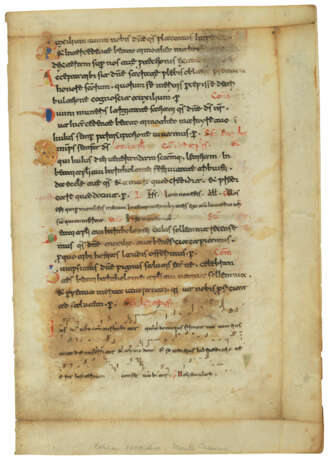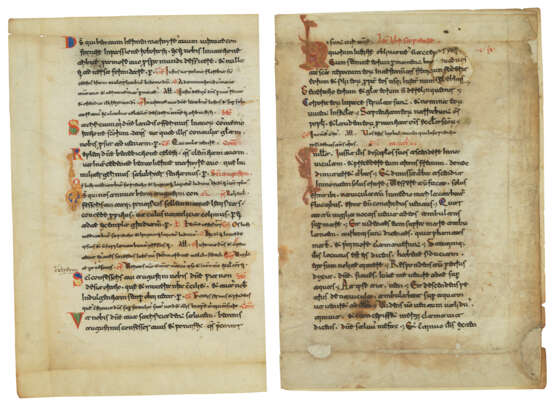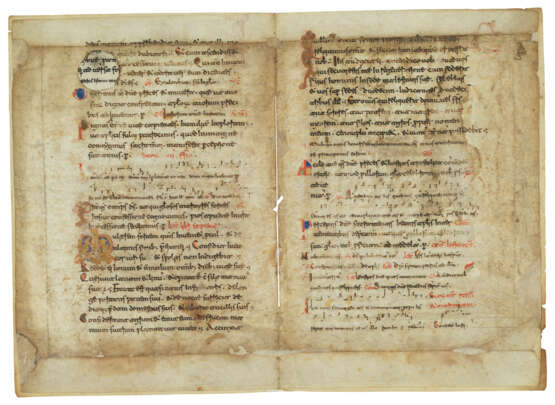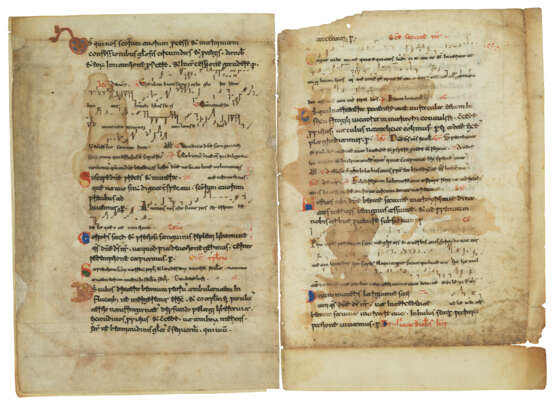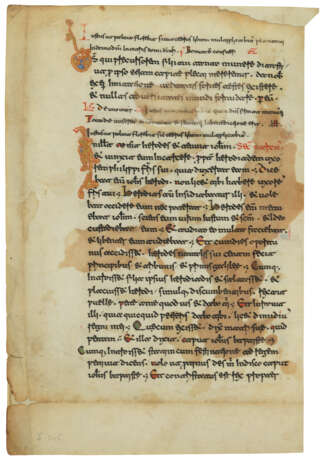ID 1053139
Лот 25 | Beneventan neumes
Оценочная стоимость
£ 30 000 – 50 000
Four leaves from a Noted Missal, in Latin, illuminated manuscript on vellum [Southern Italy, Montecassino, early 12th century]
An extremely handsome example of Beneventan script and illumination, from an exceptionally fine Missal with early musical notation described by E.A. Lowe as being in the ‘best Monte Cassino style’.
4 leaves (a bifolium and two single leaves), c.260 x 180mm, blind-ruled for 29 lines written in a very fine regular Beneventan minuscule of Monte Cassino type in 2 sizes, ruled space: c.200 x 120mm, five lines of music in Beneventan adiastematic neumes, 11 large illuminated initials with interlacing foliate designs in liquid gold edged with red and with blue in interstices; smaller initials also decorated in red on fields of blue, green, and yellow; capitals with red, yellow, and green highlighting (some staining, holes affecting the text). Bound in grey buckram at the Quaritch bindery.
Provenance:
(1) The Missal was produced in the celebrated scriptorium of the Benedictine Abbey of Monte Cassino. The present leaves were ff.ccviii–ccix and ccxxi–ccxxii.
(2) At least two, and probably all, of the known leaves were owned by Erik von Scherling c.1935; in correspondence with Professor B. L. Ullman, he reported that they came from Neapolitan archives where they had been used as wrappers.
(3) The bifolium was in the collection of E. A. Lowe (1879-1969) at Princeton, his MS 4 (see E. A. Lowe, 'A new List', 1962, p.232) who described it as being in the ‘best Monte Cassino style’. One of the single leaves was in the collection of Otto F. Ege (1888-1951), sold at Sotheby's 26 November 1985, lot 41; the other was sold at Sotheby's, 14 July 1981, lot 9, acquired by Bernard Rosenthal (1920-2017), subsequently his 'I/220'.
(4) Bernard Quaritch Ltd., Bookhands of the Middle Ages IV: Beneventan Script, cat. 1128 (1990), no 12, acquired May 1988.
(5) Schøyen Collection, MS 55.
Nine other leaves – described by Brown as of ‘Pure Montecassino type’ – from the same manuscript are known, most of them with nearly consecutive foliation:
[f. ccv] New York, Morgan Library and Museum, MS M.830.2
[f. ccvi] Marvin Colker, his sale, Christie's, The Collection of Marvin Colker, 12 December 2022, lot 36, now in a private collection.
(f. ccvii) Leiden, Bibliotheek der Rijksuniversiteit, B.P.L. 2842
(ff. ccviii–ccix) The present leaves
(f. ccx) Oberlin (OH), Oberlin College, Allen Memorial Art Museum, MS 58.19
(f. ccxi) Formerly Edward Ullmann Collection, Rome
(f. ccxii) New York, Morgan Library and Museum, MS M.830.1
(f. ccxvi) Riverside (CA), California Baptist College, P. Boyd Smith Hymnology Collection s.n.
(ff. ccxxi–ccxxii) The present leaves
(f. cxxvii) Chicago (IL), Newberry Library, Case MS 163
(f. ccxxviii) Waco (TX), Baylor University, Jennings Collection MS 2
The use of colour and/or gold for each piece of text marks this is as an extraordinarily luxurious production.
Text:
The text contains parts of the Sanctorale for St Savina; the Decollation of St John the Baptist; Feasts for Sts Timothy, Bartholomew, Hermes, and Augustine; the Commemoration of St Paul, apostles ‘infra octavas’, Sts Processus and Martianus, Octave of Apostles, the Seven Martyred Brothers, and Mary Magdalene.
Script:
The type of Beneventan script that emerged from the Abbey of Monte Cassino under the direction of abbots Theobald and Richerus distinguished itself from the Bari type in the thickness of its left-leaning strokes and the perfect alignment of horizontal strokes connecting some of the letters which produced the impression of words crossed by a single thick line. Another peculiarity is that the system of abbreviations contains a sign similar to a 3 to indicate the lack of 'm' or 'n'. The decorated initials in the present leaves, with bands of gold traced in red on the insides of the letters, with extremities terminating in trefoils or heart-shaped leaves, represent the 'new' style which came into vogue under Abbot Desiderius and can be found in such Desiderian manuscripts as Montecassino 99 (a. 1072) and Vat. lat. 1202 (a. 1072-86).
| Место происхождения: | Италия |
|---|---|
| Категория аукционного дома: | Манускрипты Средневековья и Ренессанса |
| Место происхождения: | Италия |
|---|---|
| Категория аукционного дома: | Манускрипты Средневековья и Ренессанса |
| Адрес торгов |
CHRISTIE'S 8 King Street, St. James's SW1Y 6QT London Великобритания | ||||||
|---|---|---|---|---|---|---|---|
| Предосмотр |
| ||||||
| Телефон | +44 (0)20 7839 9060 | ||||||
| Комиссия | see on Website | ||||||
| Условия использования | Условия использования |
